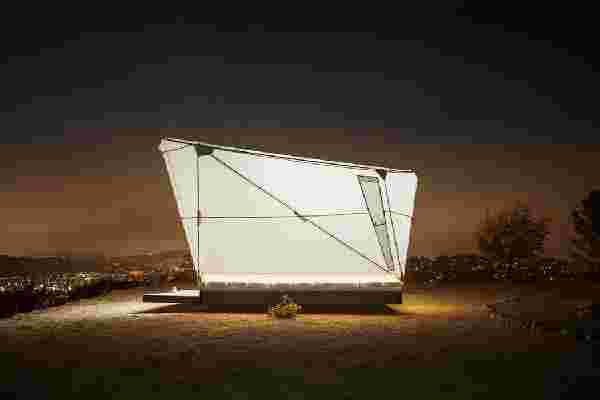
Glamping pods are cool but what if I tell you there is a portable shelter literally designed by the best in the game? Jupe is a luxe pod with a sci-fi-inspired design made by a team of multidisciplinary experts from across the housing, architecture, and engineering industries, including former SpaceX, Tesla, and AirBnB team members for modern travelers looking to escape their urban life and dive into nature. The glowing geometric structure and angular surfaces resemble a cut diamond or an interstellar shuttle more than age-old structures like RVs, cabins, tents, or yurts traditionally used for getaways.
Jupe is a portable off-grid shelter that flatpacks so you can pick any spot on the planet and pitch your tent. The futuristic silhouette is inspired by Stanley Kubrick’s 2001: Space Odyssey which explains the aluminum pole frame and glowing Firesist fabric exterior which also make it suitable to withstand different climate conditions. The mission was not to make a quick place to stay but to create a gateway to the outside world. It can be assembled in hours and gives you a 111-square foot space featuring tall ceilings, finished Baltic birch wood floors, a queen bed, and a storage area – think something right in the middle of a tiny home and glamping pod.
The large entryway doubles up as a window for your chosen scenery which you can endlessly gaze at from your queen-sized bed. The shelter also includes a 200 amp hour battery and solar array with electrical outlets, USB charging stations, dimmable LED lighting system, and a private wi-fi network if you cannot be completely off the grid. Apart from the bed, it is also furnished with designer pieces like the end tables, a desk + chair, an ottoman, and an average-sized monolith to stay aligned with the cosmos theme. Unlike most small portable shelters, Jupe’s ceilings are 11 feet tall and cloaked in luminous Firesist fabric. Like most tiny homes Jupe also optimizes its space – the Baltic birch wood floors open up to individual storage cubbies totaling 38 cubic feet which is enough space to store ten large suitcases (in case you are on the run).
“Experiencing the natural wonders of the world shouldn’t mean being forced to disconnect while staying in a less-than-inspirational living space,” said Jeff Wilson, co-founder and CEO of Jupe. “Jupe is an out-of-this-city getaway inspired by out-of-this-world ideas. During these times when most of us are craving a true escape, Jupe provides an experience perfectly suited for socially distanced travel.” The interior was designed in collaboration with renowned boutique hotelier Liz Lambert and sustainable architecture expert, TED Prize Winner, and former head of social innovation at AirBnB, Cameron Sinclair. Wilson, a design innovator and expert on modular housing, himself has lived in a 33-square-foot dwelling for a year and is known for founding the award-winning, micro-home Kasita.
Mobility is at the core of Jupe’s design and hence chassis foundation has been created in a way that involves no decking or foundation to be built which makes the shelter adaptable to any terrain, level or not, and leaves the land minimally disturbed. Amenities in the shelter can be upgraded include a Sonos Move speaker integrated with Alexa capabilities, a locking safe, solar panels, and a porch. Jupe is an off-grid escape from the city, whether to the middle of a sprawling desert, a windswept cliff by the sea, or your own backyard.
Designer: Jeff Wilson
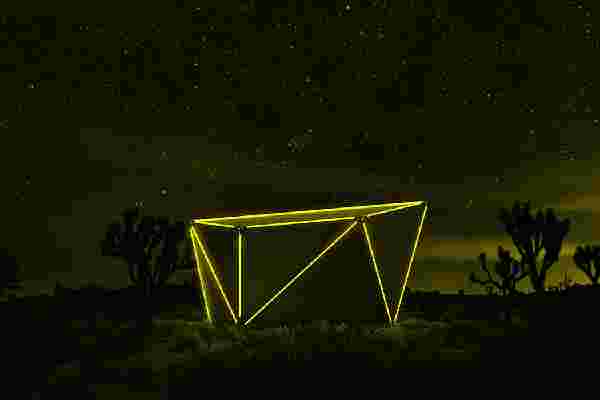
This rammed earth tiny home concept reinterprets farmhouses with a pitched green roof and photovoltaic panels!

The Rammed Earth House in Slovenia merges traditional rammed earth building techniques with modern solar energy production methods to reinterpret the early 20th-century farmhouse for today.
Rammed earth is a sustainable building method that has been around for millennia. Dating back to as early as the 9th–7th millennium BC, rammed earth has been trusted as a reliable building method and material for homes and structures on every continent except Antarctica. Bringing the method to Slovenia, three architects Merve nur Başer, Aslı Erdem, and Fatma Zeyneb Önsiper conceptualized their tiny home called Rammed Earth House to reinterpret early 20th-century farmhouses, holding onto a traditional pitched roof and introducing modern solar energy production methods.
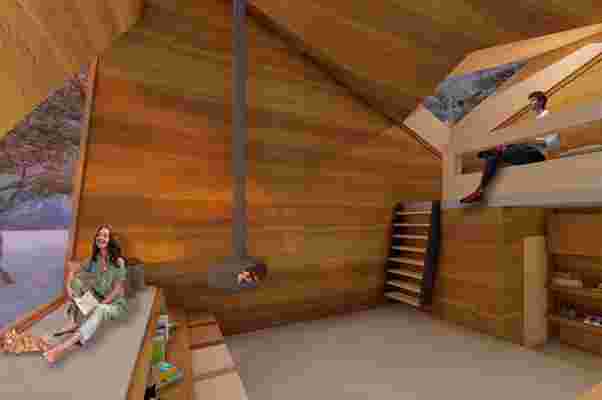
In conceptualizing the Rammed Earth House, the team of architects set out to balance contemporary energy production practices with traditional building methods. Located in Dobrava, a settlement in Slovenia’s flatland region, the Rammed Earth House is inspired by the famed floating roof designed by Slovenian architect Oton Jugovec. Since rammed earth involves compacting a mixture of subsoil into an externally supported framework, the three architects behind Rammed Earth House conceptualized a concrete foundation and timber framework. It’s generally difficult to make changes to a rammed earth structure, but the home’s overhang roof allows cement to be added in the case that extra stability is needed. Rammed Earth House is sheltered with an overhang green roof that works to protect the building material from the threat of erosion as Dobrava experiences rainy, temperate, and snowy seasons.
Rammed Earth House’s sustainable build allows for passive insulation and heating methods to cool and warm up the home.
Specifically oriented to take in the sun rays during winter months and block them out during hotter seasons, the Rammed Earth House takes cues from its surrounding environment and climate to ensure comfortable, passive heating and insulation throughout the year. Windows are also strategically placed around the house to allow cross-ventilation throughout the home and changing seasons. The green roof also holds an array of photovoltaic panels to power the home with harnessed solar energy and a rainwater collector for water recycling and an integrated septic tank system. Inside, each living area is appropriately situated to benefit from the passive heating and insulation methods. The house’s north facade, for example, features fewer windows than the west facade to decrease potential heat loss during colder months.
Designers: Merve nur Başer, Aslı Erdem, and Fatma Zeyneb Önsiper
This tiny home inspired by Scandinavian design comes with a small greenhouse and a porch swing!
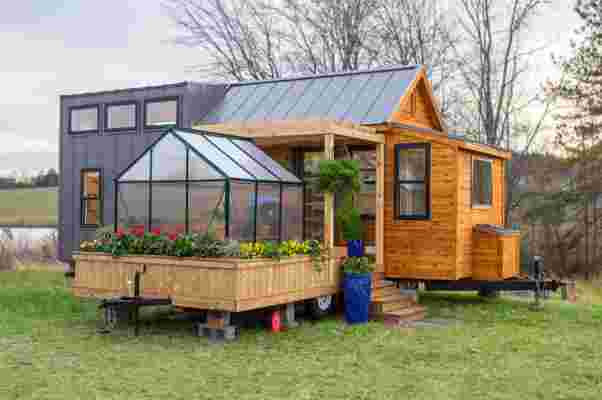
Elsa is a 323-square-foot tiny home defined by Scandinavian design that’s anchored with natural, earthy elements, like an outdoor, teeming garden and greenhouse attachment situated right beside a pergola-covered porch and attached swing for picturesque summer evenings spent in the garden.
For all of their innovative architectural feats and resource efficiency, tiny homes can’t seem to shake their tininess . That is until Elsa dropped in. While most of their appeal comes from their small size, when stretched to their edges, tiny homes can feel like small chateaus–spacious even. Designed and constructed by the small family-operated luxury tiny home building company called Olive Nest, Elsa is a not-so-tiny, 323-square-foot tiny home on wheels with an attached greenhouse, garden , and porch swing.
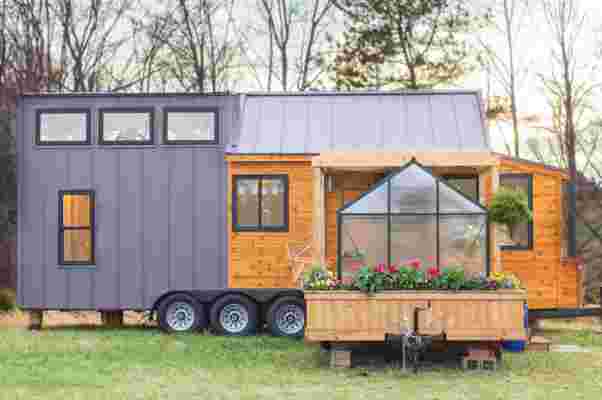
Elsa comprises 323-square-feet of living space while an exterior 85-square-foot trailer attachment keeps a pergola-covered porch, attached swing, and even a greenhouse. The natural wood exterior attachment merges with the tiny home’s cedar shiplap, anchoring the home with earthy simplicity, as described by Melodie Aho, daughter to Mary Susan Hanson and Randy Hanson, the trio behind Olive Nest. Scandinavian design, an aesthetic that embraces clean and mostly unadorned, yet functional design, defines Elsa from the inside to the outside. In direct contrast to the natural cedar shiplap, the left side of the house features standing-seam metal exterior siding, and just above the cedar shiplap section, a standing-seam metal pitched roof lengthens the inside loft bedroom ceiling.
Echoing the exterior’s natural wood personality, white-painted shiplap line Elsa’s inside walls and are brightened by natural sunlight that pours in through fourteen windows on the home’s first floor. To maintain Elsa’s lofty appeal, Olive Nest describes, “We used lots of windows and kept the ceiling high for an open, airy look.” The kitchen especially feels open, with optic-white paneling and a gleaning quartz countertop that sparkles with natural sunlight ricocheting through the windows and glass shelving. The white-painted cedar shiplap continues throughout the home, rising even to the top floor loft bedroom where a queen-size bed is framed by six more windows.
From the outside, Elsa welcomes residents and guests with a teeming porch garden and greenhouse, where you can relax on the porch swing. Then, the inside radiates a mellowed-out natural look with white-painted cedar shiplap that’s brightened up with natural sunlight. Throughout the home, accents like live-edge wood slabs and custom leather and brass fixtures work to remind residents of Elsa’s earthy simplicity, even in the details.
Designer: Olive Nest Tiny Home
A cozy reading room bordered by expansive windows draws in plenty of natural sunlight.
Upstairs, the loft’s bedroom is framed with six windows that brighten the queen-size bed’s white fabrics and the room’s white shiplap.
The kitchen trades in a worn white-painted shiplap look for optic white panels that merge with a sparkling quartz countertop.
Live-edge wooden slabs form the home’s staircase that leads to the loft bedroom.
Outside, the garden teems with plant life and flowers to remind residents and guests of the home’s primary inspiration: nature.
The greenhouse attachment buzzes with natural light outside and doubles as a privacy screen for the front porch.








